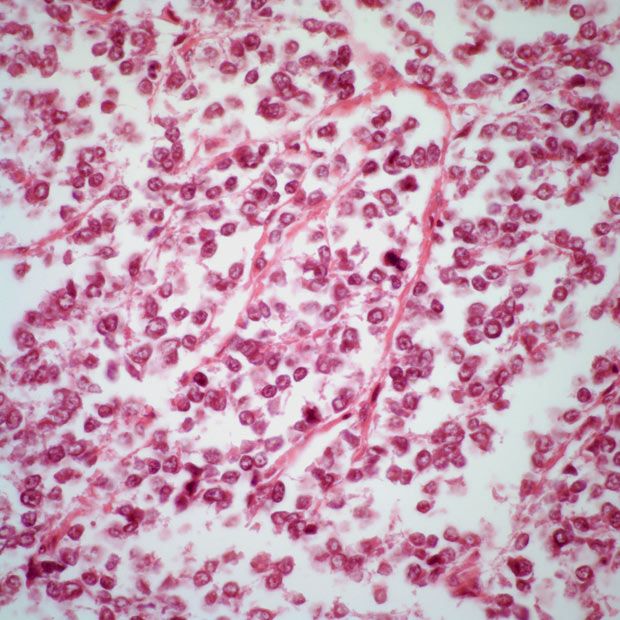Baseline ctDNA May be Prognostic in Intermediate-Risk Rhabdomyosarcoma
Findings from a retrospective cohort study suggest that circulating tumor DNA may be an important tool for risk-stratified treatment strategies in rhabdomyosarcoma.
Detection of circulating tumor DNA (ctDNA) in intermediate-risk rhabdomyosarcoma (RMS) was feasible and appeared predictive of patient outcomes, and could work to inform future strategies, according to findings from a retrospective cohort study published in the Journal of Clinical Oncology.
“Although these results indicate that ctDNA analysis is a new prognostic factor in [intermediate-risk] RMS, they also indicate that more sophisticated risk stratification approaches, such as those using recursive partitioning, may be able to best refine prognosis by integrating ctDNA detection, clinical features, and specific genomic events,” according to the authors of a retrospective cohort study.

Investigators were able to identify pathognomonic translocations between PAX3 or PAX7 and FOXO1 via Rhabdo-Seq custom sequencing assay, and appeared to be the best way to assess ctDNA in fusion-positive RMS. ctDNA was observed in 55% (n = 27/49) of patients.
Investigators also identified ctDNA in 17% (n = 13/75) of patients with fusion-negative RMS using ultralow passage whole-genome sequencing and 24% (n = 18/75) of patients using the Rhabdo-Seq assay.
The 5-year event-free survival (EFS) rate was 35.9% (95% CI, 21.4%-50.7%) for patients with detectable ctDNA vs 69.3% for those with detectable ctDNA by ultralow passage whole genome sequencing (ULP-WGS; P = .001). Additionally, 5-year overall survival (OS) rate[MOU1] was 37.3% (95% CI, 22.3%-52.3%) vs 81.2% (95% CI, 70.7%; P = .001) in each respective group.
The 5-year EFS rate was 33.3% in the fusion-negative population who had detectable ctDNA vs 68.9% who were ctDNA negative (P = .0028). In the fusion-positive population, the EFS rate was 70% for patients without detectable ctDNA vs 37% for those with detectable ctDNA (P = .045). The 5-year OS rates were 75% vs 39.2% (P = .023) in each respective group.
“Although these results indicate that ctDNA analysis is a new prognostic factor in [intermediate-risk] RMS, they also indicate that more sophisticated risk stratification approaches, such as those using recursive partitioning, may be able to best refine prognosis by integrating ctDNA detection, clinical features, and specific genomic events,” the study authors stated.
Investigators of this retrospective study assessed the feasibility of detecting ctDNA in blood samples and whether there was an association between ctDNA detection and outcomes among patients with intermediate-risk RMS who were enrolled in the phase 3 D9803 trial (NCT00003958) or the phase 3 ARST0531 trial (NCT00354835)[MOU2] . Investigators used ULP-WGS to detect copy number alterations. Moreover translocations and single nucleotide variants were detected with an RMS hybrid capture assay.
The study population included 124 patients with newly diagnosed intermediate-risk RMS who gave pre-treatment serum and tumor samples via the Children’s Oncology Group biorepository. Moreover, 75 patients had fusion-negative RMS and 49 had fusion-positive RMS. Investigators noted that the patient characteristics in the analytical ctDNA cohort were comparable with those treated in the ARST0531 trial.
In the ctDNA cohort, most patients with fusion-negative RMS had a tumor larger than 5 cm (65.3%), T2 disease (58.7%), and N0 regional node status (88.0%). For patients with fusion-positive RMS in the ctDNA cohort, most had stage III disease (65.3%), a tumor 5 cm or less in size (57.1%), and PAX3 as a FOX01 partner (73.5%).
Multivariate analyses of the entire patient cohort indicated that ctDNA detection significantly correlated with EFS (HR, 2.8; 95% CI, 1.6-5.1; P = .0005) and OS (HR, 3.9; 95% CI, 2.1-7.5; P <.0001). This correlation also applied to patients with local T2 disease and a MYOD1 L122R mutation in terms of EFS (HR, 2.0; 95% CI, 1.1-3.8; P = .02; HR, 9.2; 95% CI, 2.6-32.3; P = .0005) and OS (HR, 2.5; 95% CI, 1.2-5.0; P = .01; HR, 5.2; 95% CI, 1.1-23.5; P = .03), respectively.
For patients with fusion-negative RMS, multivariate analyses indicated that ctDNA detection correlated with EFS (HR, 4.0; 95% CI, 1.7-9.4; P = .0016) and OS (HR, 6.5; 95% CI, 2.5-16.6; P <.0001). Additionally, MYOD1 L122R mutations correlated with EFS (HR, 14.2; 95% CI, 4.0-51.3; P <.0001) and OS (HR, 9.3; 95% CI, 2.0-44.4; P = .005).
For patients with fusion-positive RMS, multivariate analyses showed that ctDNA detection correlated with EFS (HR, 2.5; 95% CI, 1.0-6.4; P = .05) and OS (HR, 3.1; 95% CI, 1.1-8.4; P = .03).
Reference
Abbou S, Klega K, Tsuji J, et al. Circulating tumor DNA is prognostic in intermediate-risk rhabdomyosarcoma: a report from the Children’s Oncology Group. J Clin Oncol. Published online February 1, 2023. doi:10.1200/JCO.22.00409
Sarcoma Awareness Month 2023 with Brian Van Tine, MD, PhD
August 1st 2023Brian Van Tine, MD, PhD, speaks about several agents and combination regimens that are currently under investigation in the sarcoma space, and potential next steps in research including immunotherapies and vaccine-based treatments.